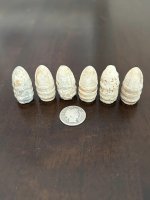BlueCricket
Greenie
So, this is Column 1, 2, and part of Column 3 of Cipher 1 in the order as given in the online Library of Congress Version of the Beale Papers pamphlet (Or the 1st 7 sentences):
Plain text reads: "Need the net ready the Tr 500th(x) 2Enter(x) Y note due the one 2 the ER 9 Dr O tho deed 2 Ed Orr 500th to 2 Ed Wire Radeo(x) 8th T(x) e-th(x) Ned Wyte died Y(x) T died the dedth the Ed Roth NE told O die ready o 500 ND(x) . . ."
The 5 Rules for the Beale Cipher 1:
Helpful Beale Cipher Particulars:
The first batch of numbers, divided by their columns (///):
Here is what I got for just raw text: "NEED YE NET-RDE YET RD Y(x)E ENTER(x)Y NOTE DOO YE ONE YE YE ER N-EYE-NE DR O YO DEED ED-ED ORR DY TO OO ED YRE RD-EH-YO (x) EY-T(x)E Y(x) NED YYTE DYEED Y(x) T DYEED YE D EDY YE ED ROY NE TODE O DYE RDY O D ND(x) . . ."
Again, the plain text reads: "Need the net ready the Tr 500th(x)2Enter(x)Y note due the one 2 the ER 9 Dr O tho deed 2 Ed Orr 500th to 2 Ed Wire Radeo(x) 8th T(x)e-th(x) Ned Wyte died Y(x) T died the dedth the Ed Roth NE told O die ready o 500 ND(x) . . ."
There is still a ways to go, and most likely some tweaking to be done, but just thought you should know what track I am on.
I have not yet tried this on Cipher 3, nor do I believe that the presence of 1 cipher might exclude others in the same transmission. So, until the "fat lady" sings (no jokes about my pudgyness plaese) HAPPY HUNTING . . .
Plain text reads: "Need the net ready the Tr 500th(x) 2Enter(x) Y note due the one 2 the ER 9 Dr O tho deed 2 Ed Orr 500th to 2 Ed Wire Radeo(x) 8th T(x) e-th(x) Ned Wyte died Y(x) T died the dedth the Ed Roth NE told O die ready o 500 ND(x) . . ."
The 5 Rules for the Beale Cipher 1:
- NO BOOK is needed.
- There seems to be NO TREASURE in this part -- just the movement of American Civil War Troops and report of their dead.
- Columns are READ VERTICALLY, keeping the numbers in their original columns.
- The LAST LETTER of each number as spelled out in English is all that is needed.
- There are NO ANAGRAMS.
Helpful Beale Cipher Particulars:
- Besides being itself and standing for "Y" as in branch or just sounded out (ex: "YTE"="White") , "Y" mostly stand for "Th" (so think of "Ye"="The" as in "Ye Old Bookstore".)
- INCLUDE the "D" in "hundreD" or "thousanD" when reading number like "1121"(=onE hundreD onE thousanD twentY onE).
- Do NOT include "anD" when reading numbers like "1121".
- At times a number like "71" may be read "seveN-onE"(=ex: "NorthEast") as opposed to "71"="seventY-onE"="YE"="The"
- The number (siX) is used as a STOP (x) unless it is in the "60" position.
- "zerO" is an option.
The first batch of numbers, divided by their columns (///):
- 71,975,758, 401, 918, 436, 39, 18, 346, 872, 8, 102, 55, 275, 919, 81, 921, 14, 17, 121, 10, 540, 39, 230, 1300, 324, 428, 202 ///
- 194, 14, 485, 370, 263 65, 88, 64,12, 36, 15, 120, 38, 131, 346, 861, 360, 1060, 23, 340, 67, 98, 232, 261, 460,1706, 403, 601, 35 ///
- 38, 40, 604 . . . ///
Here is what I got for just raw text: "NEED YE NET-RDE YET RD Y(x)E ENTER(x)Y NOTE DOO YE ONE YE YE ER N-EYE-NE DR O YO DEED ED-ED ORR DY TO OO ED YRE RD-EH-YO (x) EY-T(x)E Y(x) NED YYTE DYEED Y(x) T DYEED YE D EDY YE ED ROY NE TODE O DYE RDY O D ND(x) . . ."
Again, the plain text reads: "Need the net ready the Tr 500th(x)2Enter(x)Y note due the one 2 the ER 9 Dr O tho deed 2 Ed Orr 500th to 2 Ed Wire Radeo(x) 8th T(x)e-th(x) Ned Wyte died Y(x) T died the dedth the Ed Roth NE told O die ready o 500 ND(x) . . ."
There is still a ways to go, and most likely some tweaking to be done, but just thought you should know what track I am on.
I have not yet tried this on Cipher 3, nor do I believe that the presence of 1 cipher might exclude others in the same transmission. So, until the "fat lady" sings (no jokes about my pudgyness plaese) HAPPY HUNTING . . .




